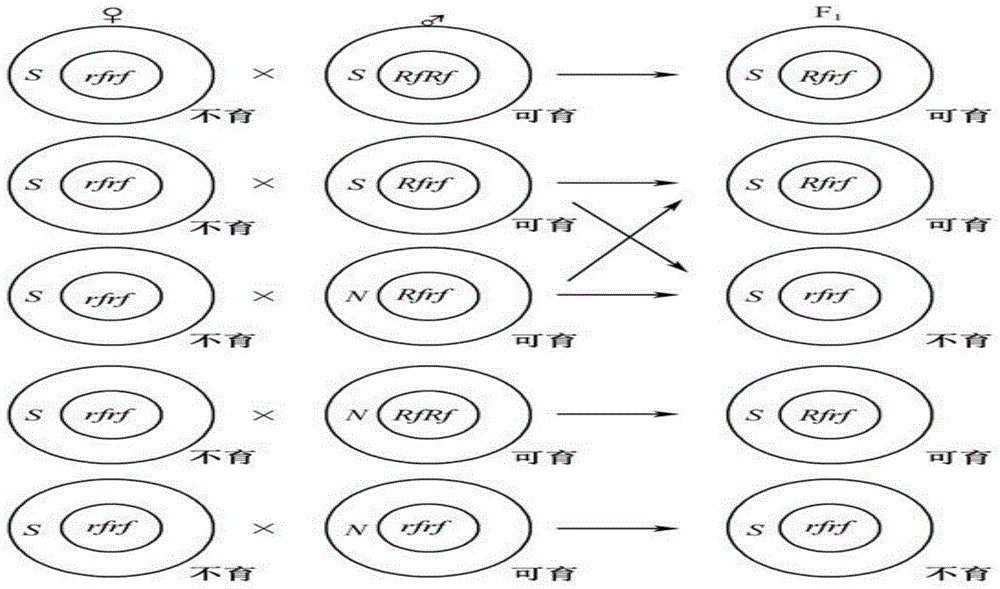Method for induced breeding of cytoplasmic-nuclear male-sterile line by using core haploidy
A technology of haploid induction and male sterile line, applied in the field of corn hybridization, can solve the problems of affecting the quality of the sterile line, long time, and narrow improvement materials for the sterile line, etc., so as to improve the purity of seed production, save labor costs, The effect of improving the efficiency of improvement
- Summary
- Abstract
- Description
- Claims
- Application Information
AI Technical Summary
Problems solved by technology
Method used
Image
Examples
Embodiment 1
[0070] A kind of method utilizing maize haploid to induce nucleoplasm interaction male sterile line, the steps are as follows:
[0071] Inducer line S(rfrf-ig-Marker)×induced material N(rfrf-DH / IB / BM)
[0072] ↓
[0073] S(rf-Haploid)×maintainer N(rfrf-DH)
[0074] ↓
[0075] S(rfrf-DH)
[0076] Specifically, the inducible line S (rfrf-ig-Marker) was first crossed with the induced material N (rfrf-DH / IB / BM), and the aleurone layer on the top of the corn kernels in the offspring was selected, and the corn kernels were green. , the corn kernels are planted, and the genotype of the plant that selects the plant that is short and the tassels do not loose powder is S(rf-Haploid);
[0077] The obtained S (rf-Haploid) is recrossed with the maintainer line N (rfrf-DH / IB), and the rf-doubled genotype can be obtained by screening the target strain of S (rfrf-DH / IB). The line cannot loose powder, and the backcross with the homozygous male parent (DH / IB) can reproduce n...
Embodiment 2
[0079] A kind of method utilizing maize haploid to induce nucleoplasm interaction male sterile line, the steps are as follows:
[0080] Inducer line S(RfRf-ig-Marker)×induced material N(rfrf-DH / IB / BM)
[0081] ↓
[0082] S(rf-Haploid)×maintainer N(rfrf-DH / IB)
[0083] ↓
[0084] S(rfrf-DH / IB)
[0085] Specifically, the inducible line S (RfRf-ig-Marker) was first crossed with the induced material N (rfrf-DH / IB / BM), and the aleurone layer on the top of the corn kernels in the offspring was selected, and the corn kernels were green. , the corn kernels are planted, and the genotype of the plant that selects the plant that is short and the tassels do not loose powder is S(rf-Haploid);
[0086] The obtained S (rf-Haploid) is recrossed with the maintainer line N (rfrf-DH / IB), and the rf-doubled genotype can be obtained by screening the target strain of S (rfrf-DH / IB). The line cannot loose powder, and the backcross with the homozygous male parent (DH / IB) ca...
Embodiment 3
[0088] A kind of method utilizing maize haploid to induce nucleoplasm interaction male sterile line, the steps are as follows:
[0089] Induced line S(Rfrf-ig-Marker)×induced material N(rfrf-DH / IB / BM)
[0090] ↓
[0091] S(rf-Haploid)×maintainer N(rfrf-DH / IB)
[0092] ↓
[0093] S(rfrf-DH / IB)
[0094] Specifically, the inducible line S (RfRf / rfrf-ig-Marker) was first crossed with the induced material N (rfrf-DH / IB / BM), and the aleurone layer on the top of the corn kernels in the offspring was selected to be purple, and the germ was green. Corn kernels, the corn kernels are planted, and the genotype of the plant that is short and the tassels do not loose powder is selected as S(rf-Haploid);
[0095] The obtained S (rf-Haploid) is recrossed with the maintainer line N (rfrf-DH / IB), and the rf-doubled genotype can be obtained by screening the target strain of S (rfrf-DH / IB). The line cannot loose powder, and the backcross with the homozygous male paren...
PUM
 Login to View More
Login to View More Abstract
Description
Claims
Application Information
 Login to View More
Login to View More - R&D
- Intellectual Property
- Life Sciences
- Materials
- Tech Scout
- Unparalleled Data Quality
- Higher Quality Content
- 60% Fewer Hallucinations
Browse by: Latest US Patents, China's latest patents, Technical Efficacy Thesaurus, Application Domain, Technology Topic, Popular Technical Reports.
© 2025 PatSnap. All rights reserved.Legal|Privacy policy|Modern Slavery Act Transparency Statement|Sitemap|About US| Contact US: help@patsnap.com


